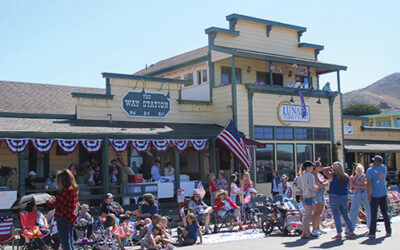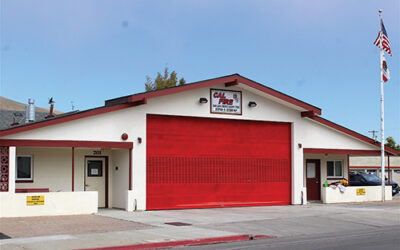The City of Morro Bay is in the act of passing a new fiscal year budget (FY 2023-24), and recently filed a required annual report on all the various funds for which it collects impact fees, stashing the money away until there’s enough to do projects.
Under the Government Code, cities that collect impact fees must compile an annual status report on those monies, which are mandated under the Mitigation Fee Act to be included in reporting starting 5-years after collected.
Morro Bay has several of these impact fees for which it charges varying amounts depending on the development being proposed and in some cases the location too.
Assistant City Manager/Admin Services Director, Sarah Johnson-Rios, compiled the report for Morro Bay and said the amounts given in the report “represent the entirety of any fund that is more than 5-years old.”
The system is how the City plans for and pays for specified projects and public improvements on things like parks, infrastructure and public facilities. “A portion of the fees currently deposited in the City’s Development Impact Funds for: Administration, Streets, Highway 41/Main Street, Traffic Impact, Storm Drain, Calvary Baptist Drain, Sewer Master Plan, and Flood Hazard Plan,” Johnson-Rios’ report said.
One of the funds it has been collecting money on is the “Administration Development Impact Fee Fund” which currently has $261,000 in it that has yet to be spent.
It justifies the fees and holding on to them because “the unexpended funds described above and the purpose for which they were generated because expanded City facilities are required to accommodate the additional service needs associated with the properties that paid these fees.”
Indeed, this is the same justification used for all of these fee funds.
The City anticipates the fees will be moved around to a fund where they can be spent in 2024, assuming they have identified a project by then. Otherwise under the law, they will just change the date to sometime in the future.
There is $45,600 in the “Street Maintenance Development Fee Fund” that the City expects to spend this year.
The largest impact fee project at this point is the Highway 41/Main Street intersection, which the City is planning to rebuild either with a roundabout or a traffic light. (The City Council is supposed to decide which project it wants to pursue at it June 13 meeting.)
Funding has always been the bane of this project, which has seen cost go up greatly for the preferred project — a roundabout. Now the City is estimating the roundabout there will cost from $8-$12 million.
According to Johnson-Rios’ report the estimated total cost for the intersection is $8.87 million. “The City’s funding sources will include unexpended Highway 41/Main Development Impact Fees of $45,242, $1,800,000 in Measure E District Transaction Tax, $600,000 General Fund appropriation, $70,630 Transit Fund appropriation, $3,282,705 in grant funding, and other available capital funding sources.”
The San Luis Obispo Council of Governments (SLOCOG), the agency that doles out State and Federal Highway monies for local roads projects, is holding millions in allocations to the project over the past decade or more.
The “Traffic Development Impact Fee Fund” currently has $30,900 in it and is to be used to “design and implement traffic improvements to mitigate impacts of new development,” according to Johnson-Rios’ report.
Something called the “Storm Drain Development Impact Fee Fund” has just $4,200 in it. It’s purpose is to “design and improve the City’s storm drain facilities to accommodate new development.”
And something called the “Calvary Baptist Drain Development Impact Fee Fund” has $314 in it. Estero Bay News asked Johnson-Rios what this fund was for, as there is no church called “Calvary Baptist” currently in Morro Bay. It’s apparently so old its purpose has been forgotten.
“The small balance in the ‘Calvary Baptist Drain Development Impact Fee,’” she said, “is an old, small balance that has been carried forward. Staff is researching the history of that particular fee.”
The “Sewer Master Plan Development Impact Fee Fund” has just $37,200 in it; and the “Flood Hazard Development Impact Fee Fund” has $17,300 in it. The purpose of these monies is to improve flood hazard areas in the city, according to the report. The City is planning to temporarily repair Preston Lane, which was torn up greatly by this past winter’s fierce storms and flooding in January and March, but that project was budgeted at $100,000.
The City also collects so-called “Government Impact Fees” on developments intended to help pay for services like police, fire, and infrastructure — streets and storm drains.
“Government Impact Fees,” the report said, “are collected to ensure that new development pays the cost of infrastructure expansion required to meet the needs of that new development, effectively transferring the cost burden of growth from the existing rate and taxpayers.”
The various fees in this category and their balances as of FY 2021-22 are: Administration — $649,00; Police Fees — $47,700; Fire Fees — $82,100; Street Fees — $598,800; Parks Fees — $289,600 and Storm Drain Fees showed a balance of zero dollars. Overall, these funds have $1.6 million.
As for expenditures, the City transferred some $9,900 to help pay for a pipeline repair job at Kern and Anchor streets; and $23,000 to help pay for the new bocce ball courts at Shasta and Kennedy Way.
It also took $1,400 out of the fund to repave the annex (parking lot) at the police station.
Under “Potential Future Projects” the City lists $400,000 for “Citywide Capital and Facilities Planning;” and $159,000 for the police department to get an automated license plate reader camera system. The fire department shows no planned projects but has a impact fee balance of $82,100.
Potential street projects include a project to renovate the Rock restrooms ($75,000) and making the intersection of Main and Quintana more ADA accessible for $180,500.
The City Council has also allocated Community Development Block Grant (CDBG) monies in each of the past two years to this project.
Under Storm Drain Impact Fees, the City lists $120,000 for storm drain repairs on Sequoia Court; and $83,000 for storm drain repairs at Juniper and Elena (total $203,000).
Parks projects listed were — $120,000 to improve the parking lot at Lila Keiser Park for handicap access; and $30,000 for the bocce ball courts.
The City lists $1.16M in expenditures planned out of the $1.66M available.
Under the Affordable Housing In Lieu Fees the City started with $257,300 balance in 2021-22 and allocated $150,000 to the low income apartments being built at the intersection of Hwy 41 and Sunset Avenue by the Housing Authority.
As for Sewer Impact Fees, the City transferred all of the money out of this fund, $142,300 to the Water Reclamation Facility (WRF) project leaving a zero balance.
The same was done with $142,000 in the Water Impact Fees Fund, zeroing out that fund, too.
Johnson-Rios explained the intricacies of some of these fees.
“Regarding the Main/Hwy 41 impact fees,” she explained, “those are based on the location of the development [only subdivision, commercial or multi-family projects]. These types of developments where the intersection would be primarily used to get to and from the development are required to provide a traffic study to determine how much their development would increase traffic at the Main/ Hwy 41 intersection.
“The increase of traffic to that intersection is used to determine the percentage of the developments shared cost to pay for the roundabout project.”
Some of these fees are mandated under State Law. For example, the law that requires subdivisions to provide park space or pay in lieu fees is called the “Quimby Act.”
“It is a part of the Subdivision Map Act and used as a condition for approval of a parcel or tract map,” Johnson-Rios said. “A parcel map is required when a developer subdivides land into 4 or less lots and tract map is for 5 or more lots. This developer must dedicate a portion of the land for a park or pay an in-lieu fee to the agency for park lands, improvements, community centers, recreation facilities, trails or open spaces. Park impact fees are for developments that do not require a parcel or tract map.”
The Subdivision Map Act dates back to the early 1900s.



